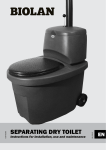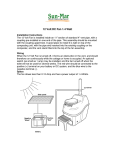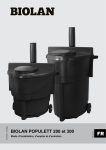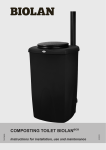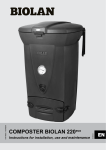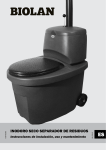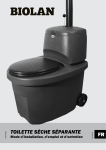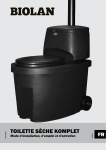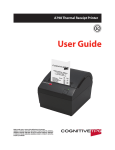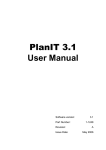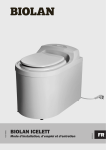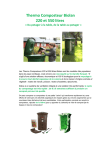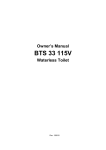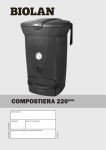Download BIOLAN POPULETT 200 and 300 Instructions for installation, use
Transcript
Instructions for installation, use and maintenance 05/2012 70578600, 70578800 BIOLAN POPULETT 200 and 300 EN 1000 mm BIOLAN POPULETT 200 and 300 Instructions for installation, use and maintenance The Biolan Populett is an odourless, tidy and environment-friendly toilet. The Populett can be installed in two different ways, so that it separates either the seep liquid or urine. Its operation requires neither water nor electricity supply. Contents Component list EN-2 1.Planning and installation EN-2 1.1Technical specifications EN-2 1.2Placing in the toilet space EN-2 Component drawing EN-3 1.3 Installing the ventilation pipe EN-3 1.4Routing the liquids EN-4 2. Use and maintenance EN-5 2.1Before use EN-5 2.2Adjusting the disc valve in the seat top EN-5 2.3What can be placed in the Populett toilet? EN-5 2.4Using bulking material and the Compostmixer EN-5 2.5Year-round use of the toilet EN-5 EN-6 2.6 Emptying 2.7 Emptying the liquid canister EN-6 EN-6 2.8 Cleaning 3. Post-treatment and use of the compost EN-6 3.1Need for post-composting EN-6 3.2Using cover soil EN-7 3.3Maturing cover soil to compost soil EN-7 3.4Testing the maturity of the compost soil at home EN-7 4. Problems that may occur EN-7 4.1Odour EN-7 4.2Insects or maggots EN-7 Disposal of the product EN-7 Biolan Accessories EN-8 About the guarantee EN-8 EN EN-1 Component list Com- Part name ponent EN Number Material 1 pipe cap 18780250 PE 2 ventilation pipe with sleeve Ø 110 x 3.4 - 1000 mm 28780120 PE 3 sliding sleeve 18780200 PE 4 thermal seat Pehvakka 70578500 EPP 5 inlet air valve body and 18792901 PP 6 inlet air valve cover PE 7 top (Populett 200 / 300) 17780020 PE 8 separating flap 200 x 220 mm 18780090 PVC - soft- 50 9 separating net 200 x 220 mm 18780110 PE 10 convex sticker Biolan 27710360 PE 11 locking rubber for the top 19734110 EPDM 12 locking rubber washer 18726140 PE 13 locking rubber screw 20010012 ZN 14 flexible liquid pipe, black 32 mm 28578010 PE 15 lead-through rubber 30/40 19780050 EPDM 16 transport wheels 29780923 RST+PP+EPDM 17 retainer clip, with cap 20700004 ZN 18 tank 200 (Populett 200) 17780010 PE 19 tank 300 (Populett 300) 17782010 PE Accessory 20 Cover for replacement tank 17780190 PE In addition to the components illustrated in the component drawing, Populett 200 and 300 also include: Compost and Toilet Bulking Material, 40 l 70562100 package PE intermediate bottom plate 17780030 PE holder strap for intermediate bottom 700 x 30 mm 20780040 nylon Populett 200, separating pipe Ø 75 x 2.7 - 550 mm 28780080 PE Populett 300, separating pipe Ø 75 x 2.7 - 890 mm 28710240 PE holder strap for liquid pipe 200 x 30 mm 20780100 nylon template 27780170 paper user manual Finnish/Swedish 27780180 paper user manual in 10 languages (export products only) 27780190 paper Compostmixer 70575200 In addition to the components illustrated in the component drawing, Populett 300 also includes: Wind Fan 70572500 1.Planning and installation When locating the Biolan Populett, provide sufficient space for use and maintenance of the toilet, for installation of the toilet through the wall of the toilet building, and for routing of the ventilation pipe. How the seep liquid or the seep liquid and urine shall be conducted into the tank or relevant treatment facility also needs to be taken into account. The unit can be placed directly on sufficiently firm ground. Before building the toilet, plan the access route required for maintenance behind the toilet and for the post-composting procedure. You can install the Populett in an existing toilet building taking into account that the structure of the building must be modified in order to enable correct positioning of the toilet unit. When planning a new toilet building, take into account the space requirement of the unit. See the dimension drawing. 1.1Technical specifications • • • • • depth of the seat part inside the toilet building about 55 cm width of the seat part inside the toilet building about 89 cm height of the seat part 51 cm overall height: Populett 200 93.5 cm, Populett 300 128.5 cm volume of the tank: Populett 200 about 200 l, Populett 300 about 300 l • weight: Populett 200 about 27 kg, Populett 300 about 30 kg • external diameter of the liquid pipe 32 mm • external diameter of the ventilation pipe 110 mm, length about 230 cm EN-2 1.2 Placing in the toilet space Install the Biolan Populett through the wall and the floor so that the top of the tank (part 7) will serve as the seat ring. The body, which serves as a tank for the toilet waste, is supported on the ground and at the same time it supports the seat part. The distance from the toilet floor to the ground surface must be 37 cm for Populett 200, and 71.5 cm for Populett 300. Thus the toilet unit will be supported both by the ground and the edge of the toilet floor. Make a smooth and durable bed for the toilet unit, such as, for example, a gravel bed, covered by film-faced plywood or a concreted bottom structure. While creating the openings and bottom structure of the building, put the toilet unit occasionally in place so as to find out where the openings still need to be reworked. Using the sawing template and the dimensions provided as an aid, saw a suitable opening for the toilet in the floor and in the wall. Depending on the manufacturing technique, the size and shape of the tank vary slightly. This means that you may have to enlarge the hole a bit or the seam of the floor and the tank will not be completely tight. Avoid, however, making the openings too large, because a too wide chink between the toilet building and the toilet unit is not a good thing. Cover the space between the rear wall of the toilet building and the toilet unit with a strip (Fig.1). Put the Populett in place without the wheels and shaft. Put the transport wheels (part 15) in place only for moving the toilet unit. Component drawing 1.3 Installing the ventilation pipe The seat top is provided with a Ø 110 mm hole for the ventilation pipe. Install the sliding sleeve (part 3) with the Compostmixer in the hole. Insert the ventilation pipe (part 2) only about 10 cm inside the sliding sleeve (part 3). Route the ventilation pipe without bends from the toilet unit over the roof ridge along the wall either passing the eaves or through the roof. Seal the lead-through on the roof using sealant suitable for the roofing material. The sealant can be purchased from any hardware store. If you have to make some bends, take note that the curvature of such bends must not exceed 33 degrees. Any bends in the ventilation pipe impede natural ventilation, causing odour and moisture problems. Populett 200: Saw off the sleeve from one end of the ventilation pipe (part 2). Put the pipe cap (part 1) on the ventilation pipe to ensure that rainwater cannot enter the toilet. It is possible to improve the ventilation and the evaporation of moisture using the Biolan Wind Fan (see Accessories on page EN-8), available as an option. Populett 300: Saw off the sleeve from one end of the ventilation pipe (part 2). Install the Wind Fan on the ventilation pipe. Remove the 75 mm reduction sleeve from the Wind Fan before installation. 1 2 Any bends in the ventilation pipe impede natural ventilation, causing odour and moisture problems. 2 4 3 EN 6 8 5 12 13 11 20 8 9 10 12 13 11 19 15 14 18 16 17 EN-3 1.4 Routing the liquids Connect the liquid pipe (part 14) to the drain hole in the rear wall of the toilet. Route the pipe to the collecting tank or treat the liquid otherwise in a due manner. Bury the collecting tank in the ground, or position it in such other way that the liquid flows under gravity into the tank. If you use the Populett in the urine separating mode, the hose must extend all the way to the bottom, in which case the surface of the liquid in the tank makes a drain trap in the hose. Thus the air cannot flow from the liquid tank back to the toilet unit. The tank must be provided with either a pressure relief valve or some other route for the replacement air. Keep in mind possible use of the toilet in winter when laying the liquid pipe and locating and insulating the canister. If it is difficult to bury the collecting tank in the ground, you can replace it with an evaporating pan. To reduce the liquid volume, set the Populett to work in the mode in which it separates seep liquid. There must be a rain lid above the evaporating pan. For neutralisation of odours, use non-fertilised Biolan Peat (see Accessories on page EN-8) in the pan. Fig. 1 1.4.1Separating the urine The structure of the Biolan Populett’s front edge enables partial separation of the urine. For the separating mode, shift the transparent separating flap (part 8) at the front edge to a position where it forms a funnel at the separating pipe (see Fig. 2). During winter use, the separation reduces build-up of mass susceptible to freezing. As urine is directly conducted away, it will not be absorbed by the bulking material and freeze in the tank. Although the Biolan Populett is set to separate urine, seep liquid will also come out of the unit. It is drained off from the unit together with the urine. If the Populett is set to separate urine, more liquid will be created for collection and treatment. Take this into account when dimensioning the treatment system. In a toilet that separates urine, the mass remains dryer, which makes emptying the toilet easier. 1.2.4Separating the seep liquid It is possible to operate the Populett in a mode in which it only separates seep liquid. Leave the separating flap (part 8) at the front edge in front of the separating pipe so that it will direct the urine into the toilet waste (see Fig 3). The excess liquid that is not absorbed by the bulking material or the toilet mass is separated by means of the intermediate structure of the bottom. Thus less liquid but more mass will be created in the toilet, especially in winter, compared with working in urine-separating mode. EN Fig. 2 Liquids rich in nutrients must not be allowed to enter the soil as they cause an excessively concentrated nutrient load. What is seep liquid? Excess liquid on the bottom of the dry toilet which has not been absorbed by the toilet waste is called seep liquid. This liquid is rich in nutrients, but contains microbes. Therefore it is recommended that it be kept in storage for about a year before being used as fertiliser. Seep liquid is also an excellent activator for garden compost. Which one of the two optional liquid separating methods would suit us best? Separation of seep liquid = only a small amount of liquid is created a summer cottage neither a big garden, nor objects of application for the liquid no place for a large liquid-collecting tank Separation of urine = large amount of liquid created a cottage used also in winter or, for example, frequent public use a garden where liquid rich in nutrients can be utilised possibility to accommodate a large tank for collecting urine EN-4 Fig. 3 2. Use and maintenance 2.1 Before use Put a layer about 5 cm thick (about 20 l) of Biolan Compost and Toilet Bulking Material onto the intermediate bottom of the Biolan Populett in order to prevent the liquid separation system from getting clogged. If the toilet is to be used in urine-separating mode, set the separating flap (part 8) into a position, where it directs the flow into the separating pipe. If the unit is to be used in seep-liquid-separating mode, leave the flap on the separating pipe (Fig. 2). 2.2Adjusting the disc valve in the seat top Ventilation of the Biolan Populett is controlled by means of the disc valve (parts 5 and 6) in the seat top. Keep the disc valve open during summer to ensure the ventilation remains efficient and the evaporation of liquids intensive. Keep the disc valve almost closed during winter to reduce heat loss from the compost. When the toilet is not in use, keep the seat lid closed to ensure correct operation of the ventilation. 2.3What can be placed in the Populett toilet? The Populett is intended for composting toilet waste. Do not put into the toilet anything that hampers the composting process or does not compost, such as: • debris, sanitary towels • chemicals, lime • detergents, washing water • ash, cigarette butts, matches 2.4Using bulking material and the Compostmixer Every time after the toilet is used, apply approximately 0.2-0.5 litres of Biolan Compost and Toilet Bulking Material over the left matter. Applying suitable bulking material is essential for proper operation of the toilet. We recommend using the Biolan Compost and Toilet Bulking Material as bedding. This efficiently absorbs odours and keeps the toilet compost airy. To extend the emptying interval of the toilet, use the Compostmixer to loosen the toilet mass and to smoothen out any uneven filling. Move the Compostmixer inside the mass to and fro several times in all directions. Use the Compostmixer as required, however at least after every 10-15 times of use. After use, leave the Compostmixer in its lower position inside the ventilation pipe (Fig. 4). Fig. 4 EN 2.5Year-round use of the toilet The toilet waste freezes in frost. Freezing damages neither the unit nor the compost mass. Decomposing of the compost mass will continue when the air temperature rises. The capacity of the toilet can be increased by utilising the urine-separating functionality of the Populett. Empty he liquid tank in the autumn, and observe its filling level to prevent it from cracking due to freezing. Fig. 5 EN-5 2.6Emptying Empty the Biolan Populett as soon as it fills up. Empty the unit completely. The emptying shall be carried out either by shovelling, by turning the body of the toilet upside down, or by tipping it over using the tail lift of a waste truck. The Populett toilet is fitted with a bracket for the waste bin lift of the truck. Emptying: 1. Take the liquid hose out from the canister/tank and fix it to the hose bracket by turning. 2. Pull the Compostmixer to its rear position. 3. Lift off the sliding sleeve from the toilet unit (Fig. 5). 4. Pull the unit out of the building (Fig. 6). 5. Tilt the unit so that you will be able to put the transport wheels (part 16) in place. 6. Transfer the unit to the emptying location or leave the mass inside the tank for composting and replace it with a new tank (Fig. 7). We recommend that a toilet used only in the summer be emptied in the spring, before using for the first time. The emptying process is most convenient and easiest at this stage. 2.7Emptying the liquid canister Empty the seep liquid canister as required, however, at least once a year. Utilise the seep liquid, rich in nutrients, as a source of nitrogen for compost. In particular, this improves the composting process of garden compost that is rich in carbon but poor in nutrients. You can use seep liquid as fertiliser for ornamental plants in the yard and garden. A safe dilution ratio is 1:5. You can also use undiluted seep liquid, but then you must water the area carefully after the application to avoid early blight. Fertilising in the autumn is not recommended so as not to disturb the preparation of perennial plants for winter. The recommended storing time of seep liquid before use as fertiliser is approximately one year. 2.8Cleaning You can wash the thermal seat of the Populett using any common domestic cleaning agents. Likewise, you can wash the unit externally using domestic cleaning agents. The liquid pipe (part 14) and the liquid trough under the intermediate bottom shall be checked once a year and cleaned as necessary. There is no need to wash the toilet tank when emptying it. Fig. 6 EN 3. Post-treatment and use of the compost Compost soil changes and develops constantly. It should be used in a different manner in different stages of its development. Typically compost soil is divided into two groups based on its maturity: cover soil and compost soil. 3.1Need for post-composting The grade of maturity of the compost mass emptied from the Biolan Populett depends on how frequently the toilet is being used, i.e. how long the waste lay in the unit before emptying. Recommended composting time for toilet waste is one year prior to application to ornamental plants and two years before use in kitchen gardens. During ordinary use, the compost waste does not have enough time to compost sufficiently in the Populett, which is why post-composting is necessary. A replacement tank, which makes composting of the waste neat and easy, is available for the Populett 200 and 300 (see Accessories on page EN-8) as an option. Toilet waste can also be composted together with garden waste. Fig. 7 EN-6 3.2 Using cover soil By cover soil we mean the semi-mature compost mass. At this stage, the toilet waste has already decomposed. Harder wood matter has not decomposed yet: thus the semi-mature compost soil has a rough texture and look. The cover soil may still contain substances that prevent growth. This means it must not be used as substrate but as cover on top of the soil. 3.3Maturing cover soil to compost soil If you continue to compost the cover soil, it will mature into proper compost soil. For post-composting, it is advisable to use the replacement tank, available for the Populett as an option, or a composter with cover, such as e.g. the Biolan Garden Composter or the Biolan Stone Composter (see Accessories on page EN-8) to prevent rainwater from flushing away the water-soluble nutrients. In a couple of months, the compost matures into compost soil of a dark brown colour and aggregate structure, from which source substances, except for bigger wood splinters, can no longer be distinguished. 3.4 Testing the maturity of the compost soil at home The maturity of the compost can easily be tested at home by sprouting garden cress. 1. Fill two pots: one with compost and the other one with growth peat. 2. Sow the seeds, cover with plastic and place the pots in a sunny place. 3. In two weeks you can judge from the result whether the compost is sufficiently mature or not. If the plants sprout significantly better in the pot with peat, the compost still contains substances that impede growth. 4.2 Insects or maggots The most common flies appearing in dry toilets are small fungus gnats, fruit flies etc. Using a fly net does not prevent these tiny flies from entering the compost. The fly maggots are light in colour, and can try to get out of the toilet unit via the seat part, if the conditions inside the toilet are too hot for them. The presence of flies in the compost often indicates that the compost mass is too wet. 1. make sure that the bulking material used is Biolan Compost and Toilet Bulking Material (see Accessories on page EN-6). Some beddings (e.g. fresh chips of deciduous trees) attract flies to the compost. The pine bark used in the Biolan Compost and Toilet Bulking Material, however, acts as a repellent. 2. add a thick layer of bulking material on top of the compost. 3. do away with any flying insects in the toilet space using pyrethrinbased spray. Consult your local garden centre to select a suitable product. Repeat the spraying at intervals of at least two-three days to exterminate the new generations emerging from eggs and maggots. Spray insecticide also inside the toilet unit and close the lid. Repeat the spraying until flying insects can no longer be spotted. Please consult your local waste advisor for regulations on composting. Visit www.biolan.fi for more information on composting and the utilisation of urine. The compost is not mature, if the seeds germinate, but the plants soon wither away. 4. Problems that may occur 4.1Odour If installed, used and maintained correctly, the room where the Biolan Populett is located will remain odourless. Odour occurs only for a short while after the seat ring lid is lifted up. This is normal with natural ventilation. If continuous odour problems persist: 1. make sure that the ventilation pipe is routed from the top to the roof without any bends and extends over the roof ridge. If the ventilation pipe is not straight or does not extend over the roof ridge, you should improve the ventilation of the Populett 200 model by installing the Biolan Wind Fan (see Accessories on page FI-8). The ventilation can also be improved by extending the ventilation pipe with a sewage pipe Ø 110 mm. 2. make sure that the disc valve (part 6) in the seat top is open. 3. make sure that the seep liquid removal system is operational: the liquid coming out of the toilet is routed into the collecting tank. As required, check the fall of pipe and clean up the liquid pipe (part 14). 4. make sure that the bulking material used is Biolan Compost and Toilet Bulking Material (see Accessories on page EN-8). If, for example, a mixture of peat and wood shavings or other bulking material of fine texture is used, the mass may be packed too tightly. 5. make sure that a sufficient amount of Biolan Compost and Toilet Bulking Material, about 0.2-0.5 litres, has been applied after each use. 6. repeat the spraying at intervals of at least two-three days to exterminate the new generations emerging from eggs and maggots. Spray insecticide also inside the toilet unit and close the lid. Repeat the spraying until flying insects can no longer be spotted. Disposal of the product The raw materials used are presented in the component list (see page 4). Dispose of each part as prescribed. Always follow the regional and collecting-point-specific instructions. To energy-from-waste process or recycling of plastic: EPDM = ethylene propylene PE = polyethylene PP = polypropylene To energy-from-waste process: PU = polyurethane To collection of metal: RST = stainless steel ST Zn = hot-galvanised steel To recycling of paper: Paper To mixed waste: PVC = polyvinyl chloride EN-7 EN Biolan Accessories Availability varies from country to country. Consult your local dealer for details. Replacement tanks for the Biolan Populett Biolan Compostmixer The Compostmixer is an excellent tool for managing the compost. The Biolan Compostmixer is made of resilient glass fibre-reinforced polypropylene, so it neither corrodes nor oxidises even over time. Product no. 70575200 Biolan Compost and Toilet Bulking Material Biolan Garden Composter Biolan Compost and Toilet Bulking Material is a blend of pure, dried and ground conifer bark, wood and peat for composting and dry toilets. Applying it regularly to the compost keeps the compost mass airy and ensures the composting is efficient and odourless. Package size: a bag of 40 litres, a bag of 85 litres Product number: 40 l 70562100, 85 l 70562500 The Biolan Garden Composter is intended for the composting of domestic, garden and toilet waste in a detached house or a holiday home. Its large, hinged cover makes the filling of the composter easier. The hermetic structure and adjustable air exchange prevent the compost mass from drying, and reduce the need for maintenance. Product number: green 70572000, grey 70576700 Biolan Peat Biolan Stone Composter Biolan Peat is clean, white non-fertilised or limed sphagnum peat. It is naturally sour. Biolan Peat is suitable for, for example, storing root crop, use as soil conditioner, and use in an evaporating pan for seep liquid. Package size: a bag of 70 litres Product number: 55544200 Biolan Pehvakka EN Replacement tank for the Populett Enables composting of the toilet waste neatly in a tank. Product number: Populett 200 – replacement tank 70578700 Product number: Populett 300 – replacement tank 70578900 Biolan Pehvakka is a hinged thermal seat, which is hygienic and durable. The flexible foam material neither cracks in use nor absorbs moisture. Both the lid and the seat ring can be lifted up, which makes thorough cleaning of the seat easier. It can be cleaned using any common domestic cleaning agents. The seat can be fitted in toilets where the distance between the hinge pins is either 16 cm or 18 cm. Product number: 70578500 The Biolan Stone Composter is intended for the composting of domestic and garden waste in a detached house or holiday home. Thanks to its large size, it is well-suited to the composting of garden waste and toilet waste from a summer cottage. The Biolan Stone Composter, having the colour of natural stone, merges well with its surroundings, and is wellsuited even to small yards. Product number: red granite 70573100, grey granite 70573200 Biolan Suotis Biolan Suotis is a biochemical seep liquid filter for a dry toilet. The device cleans up the seep liquid so that it can be conducted directly into the ground. It is not suitable for separated urine. The filter operates by gravitation and does not need any electricity supply. The capacity of the device is 60 litres. Product number: 70572100 Biolan Wind Fan The Biolan Wind Fan is an efficient exhaust fan that is powered by the wind. It is ideal for improving the ventilation in warehouses, dry toilets, bathrooms, small-scale water treatment plants etc., and locations that need good ventilation. The Wind Fan is made of aluminium, and thanks to its very mobile bearing, even a slight breeze can improve ventilation significantly. Product number: 70572500 About the guarantee The Biolan Populett has a guarantee of one year. 1. The guarantee is valid from the date of purchase and covers possible defects in material and workmanship. The guarantee does not cover any indirect damage. 2. Biolan Oy retains the right to decide about repairing or replacing damaged parts at its discretion. 3. Any damage resulting from careless or forcible handling of the device, from failure to observe the operating instructions, or from normal wear, will not be covered by this guarantee. For matters related to the guarantee, please consult Biolan Oy directly. Biolan Oy P.O. Box 2, FI-27501 KAUTTUA Tel. +358 2 5491 600 Fax +358 2 5491 660 www.biolan.fi EN-8












